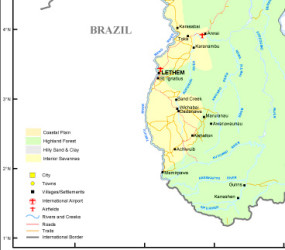With dry weather conditions “taking a heavy toll” on Region Nine (Upper Takutu/Upper Essequibo), the Ministry of Indigenous Peoples’ Affairs says it is implementing a number of support measures to bring relief to residents.
“There has been little or no rainfall in the Rupununi over the last sixteen weeks or so. Ponds have dried up and shallow hand dug wells are low on water while some have gone dry. In some places the rivers have also dried up due to the scorching heat and zero rainfall,” the Ministry said in a statement released yesterday.
Earlier this week, Stabroek News had reported Region Nine Regional Executive Officer (REO) Carl Parker as saying that the availability of water in the region was a “very serious issue” and that even if the rains were to return to the Rupununi, the region stands a chance of facing a food crisis.

The last census put the region’s population at 24, 212.
Minister of Indigenous Peoples’ Affairs Sydney Allicock had previously told Stabroek News that his ministry is working tirelessly with the Civil Defence Commission (CDC) to establish other ways to offer support to the region.
According to the Ministry, frequent reports from regional councillors, community health workers and village toshaos are being received at Lethem regarding the situation in the villages.
The South Central area, it noted, has been without rainfall for at least thirteen weeks and the Rupununi River has partially dried up. “The Villages of Baitoon and Shulinab are carefully monitoring the water levels in their wells. River water is being used to supplement the scarce well water,” it said.
Parker had said that as the current weather condition stretches on, sources of water are becoming even scarcer. The Kumu Falls, located a few hours away from Lethem, have stopped running, while two ponds in Shulinab Village have gone dry. According to the REO, he has never known the ponds in that village to ever be without water.
The Ministry reported areas in the South Pakaraimas, Yorong Paru, Paipang, Taushida, Tiger Pond and Rukumuta are “experiencing grave difficulty.” These communities are said to be currently receiving support from the CDC and the village of Karasabai as water is being transported in tanks from Karasabai with the assistance from the CDC.
On the other hand, the statement noted that the situation in the Central Rupununi district is “appreciably better” as although low, water levels in the wells are still adequate for the villages’ needs. However, the threat to agricultural crops is worrying, it said. The villages of Nappi, Kumu, Moco Moco, Simonie and Marcanata, it noted, are rationing their water supplies, while like the Kumu Falls, Moco-Moco creek will soon be dry as the weather conditions persist.
In the Deep South, it added, the villages of Shea, Aishalton, Karaudarnau and Achawib are carefully monitoring their agricultural crops, while village leaders have placed priority on the health and education sectors in terms of the water distribution plan.
Similarly, conditions in the North Rupununi are also said to be more favourable. However, although the Rupununi River still has a fair level of water, the water at the Rewa and Crash Water crossings has dried up. In the North Rupununi, as in the Deep South, the health and education sectors are being given priority in the water distribution plan.
Interventions
According to the Ministry’s statement, plans are being formulated to address possible food shortage in the event of a further prolonged dry spell.
At the same time, it said, a public awareness campaign on water conservation and health related issues is currently ongoing.
It added that the Risk Reduction Management Centre and the CDC have provided a number of 450- gallon water tanks and water pumps to aid in water distribution. Water purification tablets, one-gallon water bottles and water pumps are being sourced as well.
Further, it said 15 wells are being constructed in the North Rupununi District by the Guyana International Mission as a humanitarian effort by the Full Gospel Fellowship. The organisation is a charitable group based in Region One.
The Ministry added that several more wells could also be sunk in other parts of the Region by the same group, once the requisite resources are made available. In other instances, villages have moved to begin cleaning and increasing the depth of hand dug wells.
The Ministry has also recommended that a water harvesting project at the J.R Ranch at Manari in the Central Rupununi District be studied with a view to replicating it for the benefit of indigenous villages and communities in the region.
Additionally, the Ministry said regional health authorities are on high alert for possible health challenges which could arise, while agriculture extension officers are also on high alert as the effects of the extreme dry conditions continue to affect the region’s food production.
Moreover, village leaders are said to have put measures in place to prevent the poisoning of creeks, streams and rivers for the harvesting of fish, while bathing in creeks has now become a prohibited practice.
Other measures listed by the Ministry include the monitoring of the
differently-abled and senior citizens, with frequent reports being submitted on the status of such individuals.
Parker had also noted that approximately 85% of the hand dug wells in the different districts have already dried up, while 50% of those facilitated by the Guyana Water Incorporated (GWI) have also failed. Thus, the GWI wells are unable to properly supply residents and government facilities in the district.
As a result, some residents have engaged in digging private wells, an illegal act that allows these residents to tap into the aquifers and ultimately hindering other residents’ access to water as aquifer levels continue to drop.




